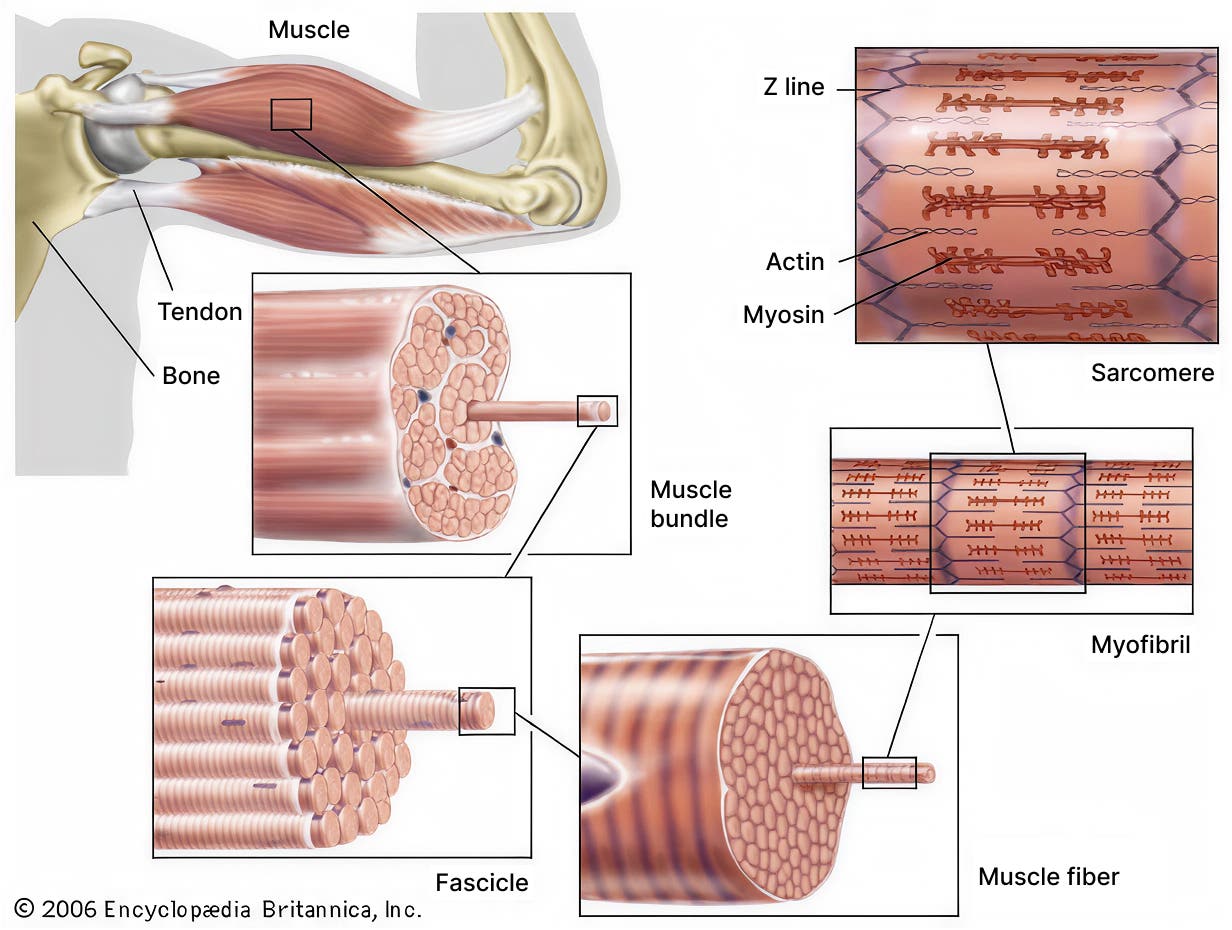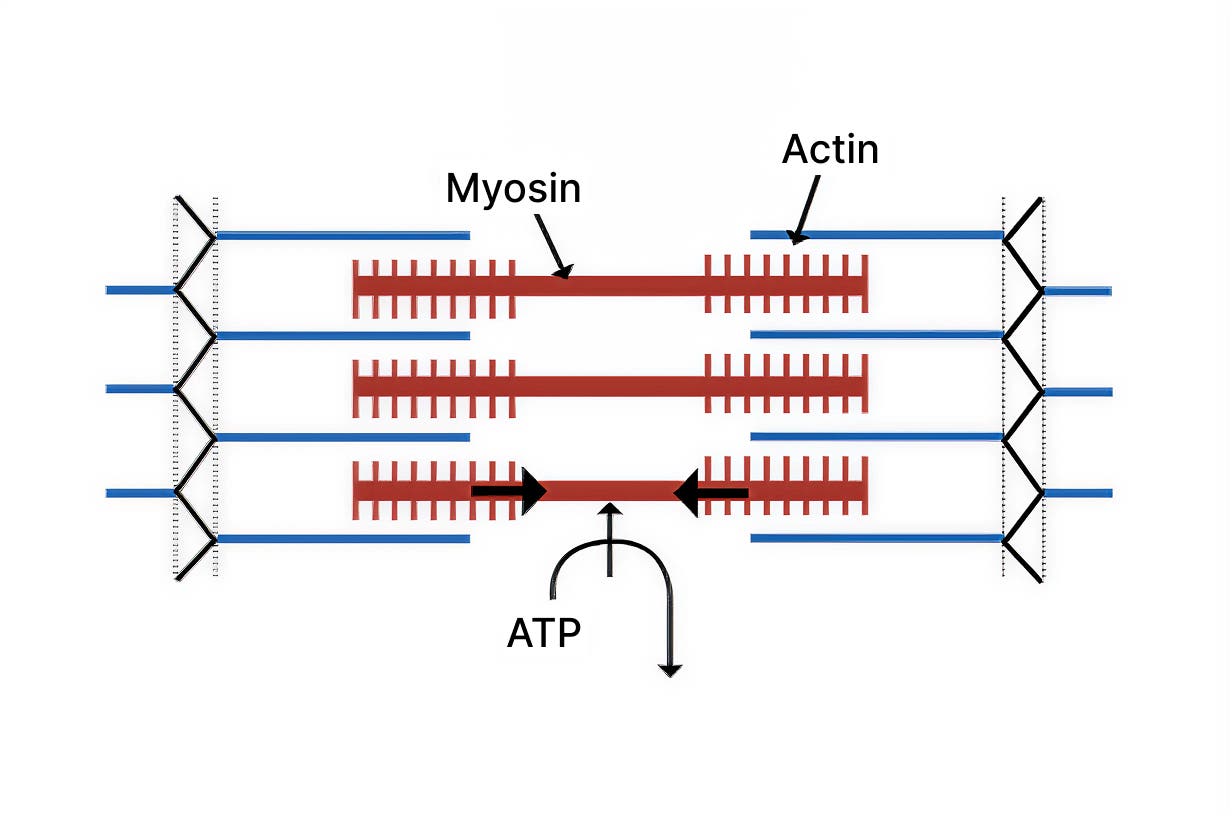Understanding the structure of muscles and how they work can help you train smarter and more efficiently. Skeletal muscles, which produce movement and support posture and stability, are made up of bundles of parallel muscle fibers, also known as muscle cells.
Inside muscle cells are chains of myofibrils, which contain repeating units called sarcomeres. Each sarcomere is made up of two long protein filaments – actin and myosin. These actin and myosin filaments slide past each other to cause muscle contraction and relaxation, or put simply, forming the basis of all movement.
Let’s take a closer look at how this process works and why it matters for your training.
Inside the muscle
We’ve introduced a lot of new terms right from the jump, so here’s a quick guide to the key concepts and what they mean.
| Muscle bundles | Think of it as a strong cable of smaller “wires” |
| Muscle fibers | Long, parallel muscle fibers – each a cell called a muscle fiber – that can contract individually; found within muscle bundles |
| Myofibrils | Located within muscle fibers, bundles of protein filaments found in striated muscles (mostly actin and myosin) |
| Sarcomere | Repeating unit within a myofibril; responsible for contraction |
| Actin | Thin filaments of the sarcomere |
| Myosin | Thick filaments of the sarcomere |
The sarcomeres make up the main contractile structures that contribute to our overall muscle mass. The rest consists mainly of blood vessels, connective tissue, cytoplasm, and nerves.

How movement happens
Movement starts in your nervous system, where different types of neurons work together to send electrical signals that coordinate each muscle contraction. The brain sends electrical signals through motor neurons to muscle fibers, telling them to contract or relax.
These motor neurons have cell bodies in the spinal cord that process and relay signals to the muscles. Mineral ions, or electrolytes, help in transmitting these signals.
Inside the muscle cells, the chemical energy from ATP is converted into mechanical energy, causing the muscles to contract. The force generated through tendons, which connect muscles to bones, produces movement.
Calcium ions play a key role in muscle contraction.
Calcium activates the heads of the myosin filament, which bind to the actin filament, and the muscle contracts. When the calcium levels drop, the myosin “tilt” back to their original position and release the actin filament, allowing the muscle to relax.
Magnesium helps lower calcium levels in the muscle by blocking excess calcium from entering and facilitating the unloading of calcium, allowing the muscles to fully relax.

Why this matters for your training
Targeting muscle fibers
There are several types of skeletal muscle fibers, each with its own specific function and unique response to different forms of physical activity.
Slow-twitch muscle fibers are responsible for more endurance-based activities and are more resistant to fatigue. Think marathons, cycling, or power walking.
Fast-twitch muscle fibers are responsible for those short, powerful movements like sprints and plyometrics.
By knowing which muscle fibers your workout engages, you can plan exercises that align with your fitness goals – whether through resistance training, endurance work, or using your own body weight. Over time, consistent, targeted training – especially strength training – helps build stronger, more coordinated muscles.
The role of hydration
As discussed above, electrolytes like calcium and magnesium are essential for muscle contraction and relaxation. When these electrolytes are out of balance, like with dehydration, this can lead to muscle fatigue or even spasms, such as muscle cramps.
Maintaining proper hydration is vital, and unfortunately, the importance of water is often overlooked. Knowing how much water to drink each day helps ensure your muscles function optimally and repair properly so you can perform at your best.

A beginner’s edge
The good news for beginners: your muscles are capable of learning! The fastest way to build strength and improve coordination is through consistent, focused training that challenges your body over periods of time. And it doesn’t require intense, hour-long sessions.
In fact, for those just starting out, the “Grease the Groove” approach, or submaximal training spread throughout the day, has been shown to be incredibly effective.
This training method focuses on neurological adaptations – teaching your nervous system to activate the right muscle fibers at the right time. As a result, movements become more efficient and you become stronger, faster.
Beginners see a lot of gains in the early stages thanks to these neural adaptations.
Recovery and adaptation
Muscles and nerves adapt and improve when you exercise consistently – but recovery is equally as important.
When you challenge your skeletal muscle system through intense training and progressive overload, your muscles become stronger and more efficient, stimulating muscle growth over time. However, performing these movements while fatigued can compromise your form and increase the risk factors for injury.
What’s more, your muscles utilize that rest period to repair damaged fibers, increase muscle mass and strength, and prepare for future demands. Skipping your rest days could stall progress and limit your strength gains.
3 fun facts about your muscles
- Myofibrils give striated muscles their name. These fibrils are arranged in a precise, repeating pattern with alternating darker and lighter elements, namely actin and myosin. This is what gives the muscle cells their striated appearance under the microscope.
- Muscle force begins at a microscopic level. Even the tiniest of movements involves tens of thousands of muscle and nerve cells. True to the saying, “a chain is only as strong as its weakest link,” a muscle can perform efficiently only when all its cells function properly.
- Muscle memory is a real thing, but it actually has more to do with your motor patterns your brain retains, even if you’ve taken a break from exercise. Your body remembers these learned connections, allowing you to pick up movements again easily – just like riding a bike.
Let’s recap
To get the most out of your workouts, understanding how your muscle contraction works helps you identify areas for improvement, decide what stimuli to add, and recognize when it’s time to rest. Different types of training target different muscle fibers, and varying your approach provides specific stimuli to support different goals.
Factors like rest, recovery, and nutrition also play a critical role in performance and overall quality of life – whether it’s on race day or chasing a new personal best.
Muscle building is both an art and a science, and understanding it allows you to train smarter and continue making progress.
Sources
Open Oregon State. (n.d.). 10.2 Skeletal Muscle – Anatomy & Physiology 2e. Open Oregon State.
ScienceDirect. (n.d.). Skeletal muscle. ScienceDirect.
Kenhub. (n.d.). Muscles and muscle tissue: Types and functions. Kenhub.
Lieber, R. L. (2019). Physiology, Muscle Contraction. In StatPearls. StatPearls Publishing.
Golden, N. (2023). Understanding Fast-Twitch vs Slow-Twitch Muscle Fibers. NASM.